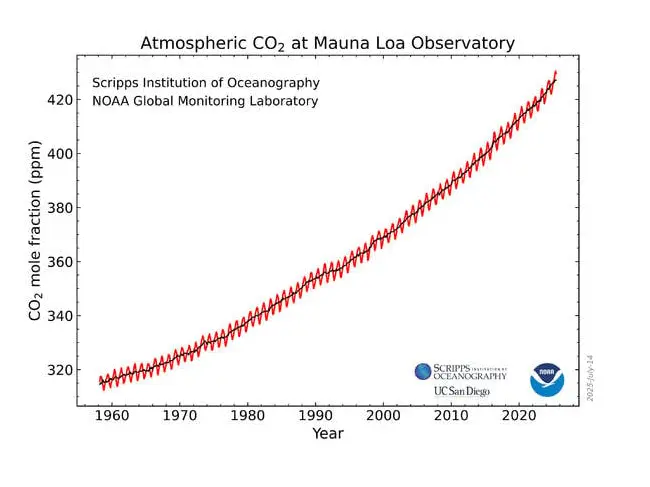The Real Reason Why Trump Is Killing The Mauna Loa Observatory In Hawai’i
Column When you don’t like the message, what do you do? You shoot the messenger, of course.
That’s the strategy being employed by U.S. President Donald Trump’s administration as it works to avoid, ignore, or bury data that prove the reality of anthropogenic global warming and its evil twin climate change.
Case in point: The Trump administration recently released its draft budget [PDF] for the country’s premier analytical agency focused on Earth systems, the National Oceanic and Atmospheric Administration. Among the many cuts to NOAA research proposed in the draft was one that would represent a death blow to the Mauna Loa Observatory, the source of the data fueling the most iconic chart in all of climate research, the time-honored and justly venerated Keeling Curve.

Radio geeks reveal how to access crucial hurricane data after US Department of Defense cut it off
READ MOREThis chart, begun by young researcher Charles David Keeling way back in 1958, chronicles the seasonal rise and fall – and unrelenting upward spiral – of the most abundant and consequential greenhouse gas heating our planet: carbon dioxide (CO2).

The iconic Keeling Curve – the irrefutable bearer of hard-to-swallow facts for those who claim that carbon dioxide can’t be exacerbating global warming.
Keeling measured greenhouse gases from near the peak of 13,678-foot (4,169 meter) Mauna Loa, Hawaii, because it is far from localized interference by our CO2-spewing civilization. His early measurements found the gas accounted for about 315 parts per million (PPM) in Earth’s atmosphere, significantly above the estimated 275 ppm preindustrial average. Thanks to its careful annual updating, the Keeling Curve chart now shows an inexorable CO2 climb to just under 425 ppm. This year it slipped briefly above 430 ppm for the first time. The growing atmospheric saturation of carbon dioxide is unarguable.
So what? Well, so this: These data are closely correlated with the rise in global temperatures that NOAA, NASA, the UK Met Office, Berkeley Earth, the Japan Meteorological Agency, and others have meticulously recorded in the ensuing seven decades. During that time, Keeling’s data have helped climate science to perfect its ability to provide support for the causation that would unarguably couple with that correlation.
This causative linkage is now abundantly clear – as equally clear are the current U.S. administration’s anti-science “Drill, baby, drill!” efforts to suppress any contradictory data, no matter how reputable.
Perhaps a refreshing review of the science supporting global warming might here be useful. First, it must be emphatically stated that global warming per se is most definitely a good thing. In moderation, that is. The problem is, as with so many good things in life, indulging in too much of a good thing – think alcohol or Marmite – can lead to disaster. And so it is with greenhouse gasses.
Those gasses manage to keep us snuggly warm because their easily excited molecular structures that enable them to absorb and then re-radiate particular frequencies of the long-wave infrared heat energy sent skyward by the Earth when it’s heated by the short-wave radiative heat energy of the Sun. Although some of that re-radiated energy escapes into space, a sizable portion of it hangs around to warm the troposphere – that’s the part of the atmosphere in which we live. The amount that warms us is juuuuust the right amount to keep the Earth from being a freeze-your-ass-off planet like Atmosphere-LiteTM Mars or a beastly spherical hell like CO2-suffocated Venus. We’re Goldilocks, with our troposphere standing in for her porridge.
If it weren’t for that greenhouse-gas blanket, simple physics (the Stefan-Boltzmann black-body equations, for you fellow physics nerds) proves that the Earth’s temperature would average about -15°C (5°F). However, thanks to CO2, methane (CH4), nitrous oxide (N2O), and trace other gasses (plus water vapor), we average around 15°C (59°F) globally. But here’s the rub: Thanks to our power-hungry addiction to adding gigatons of those gasses into our atmosphere, we are messing with that fine balance.
What’s more, climate scientists have meticulously analyzed that balance to resolutely prove that other forcings such as volcanoes, solar activity, aerosols, and other climate-affecting niceties can’t account for the universally observed global temperature increases. Can we blame competing candidates for global warming? Nope. It’s not them. It’s us.
But the current US administration’s unrelenting intent to decapitate the Keeling Curve and to strangle other measurements of the many and varied factors exacerbating global warming won’t merely weaken our understanding of climate phenomena.
Their effect will be worse because the data acquisition tools Washington wants to de-fund don’t merely exist to tell us how badly we’re mucking up our home planet. They also guide us to where to best focus our climate-change mitigation efforts, and more importantly help us track how well we’re doing.
We need to both effectively target our efforts and to keep an eye on our progress.
Unfortunately, the current administration would prefer to blind us. For example, in addition to shutting down such climate-monitoring efforts as the Mauna Loa Observatory, the new management of the United States Environmental Protection Agency (EPA) has announced that it is “reconsidering” its “burdensome” Greenhouse Gas Reporting Program (GHGRP), which requires major industrial sources of greenhouse gasses to report their emissions.
In a more-sweeping move, the EPA also announced that it will “reconsider” (read, “emasculate”) its fundamental 2009 Endangerment Finding, which for the past 16 years has guided and supported what the new administration’s EPA now condemns as an “overreaching climate agenda” that has “imposed trillions of dollars of costs on Americans.”
When making that announcement, EPA Administrator Lee Zeldin promised that “The Trump Administration will not sacrifice national prosperity, energy security, and the freedom of our people for an agenda that throttles our industries, our mobility, and our consumer choice while benefiting adversaries overseas.”
To clarify his anti-science goals for this “reconsideration” effort, Zeldin recruited to this effort the justly marginalized climate-science deniers John Christy and Roy Spencer.
The empirical data objectively charted in the Keeling Curve do not suit the current administration’s agenda. To suit their short-term goals, the data collection of the Mauna Loa Observatory and all similar climate-related science must be “reconsidered”. Reconsidered? How ’bout “silenced”? The administration has made its intentions clear.
There’s an almost certainly apocryphal story that when Galileo Galilei was forced by religious authorities to abandon his evidence-based certainty that the Earth circled the Sun, he was heard to whisper to himself, “E pur si muove” – “And yet it moves.” One can imagine the last remaining Mauna Loa Observatory lab tech, when shutting down the CO2-measuring equipment which acquired the data used to update the Keeling Curve, whispering to himself, “E pur si riscalda” – “And yet it warms.” ®
Bootnote
Some of the links in this article are to pages on the EPA website that either describe current consensus science related to specific greenhouse gasses, or which detail currently existing EPA programs. Do not for a nanosecond be at all surprised if those links soon return 404 errors …
A considerable amount of time and effort goes into maintaining this website, creating backend automation and creating new features and content for you to make actionable intelligence decisions. Everyone that supports the site helps enable new functionality.
If you like the site, please support us on “Patreon” or “Buy Me A Coffee” using the buttons below
To keep up to date follow us on the below channels.

![[ANUBIS] - Ransomware Victim: Aussie Fluid Power 2 image](https://www.redpacketsecurity.com/wp-content/uploads/2024/09/image-300x300.png)

